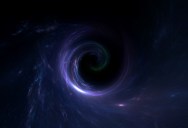Here’s Why Some Physicists Believe We’re Living Inside A Black Hole

Despite everything we’ve learned about the universe and the greater reaches of space, there is still a whole lot we don’t know.
And some physicists say one of those things could be whether or not our own planet exists inside of a black hole.
Which is hard, because black holes are one of those things that, despite how much we have learned, continue to subvert our understanding of physics.
That doesn’t stop some physicists wonder whether our universe might exist within a black hole of a larger universe.
To understand why this theory exists, you have to understand a little bit about black holes in general.
They are formed when giant stars collapse and are areas where gravity is too strong for the slightest bit of light to escape. The final state of a black hole is when it reaches equilibrium and is dependent on three things: its mass, angular momentum, and electric charge.

Astrophysicist Jean-Pierre Luminet explained more in a 2016 review.
“In classical general relativity, a black hole prevents any particle or form of radiation from escaping from its cosmic prison. For an external observer, when a material body crosses an event horizon all knowledge of its material properties is lost. Only the new values of M [mass], J [angular momentum], and Q [electric charge] remain. As a result, a black hole swallows an enormous amount of information.”
Basically, according to Stephen Hawking, black holes should emit both heat and radiation at their boundary.
“Hawking then pointed to a paradox. If a black hole can evaporate, a portion of the information it contains is lost forever. The information contained in thermal radiation emitted by a black hole is degraded; it does not recapitulate information about matter previously swallowed by the black hole. The irretrievable loss of information conflicts with one of the basic postulates of quantum mechanics. According to the Schrödinger equation, physical systems that change over time cannot create or destroy information, a property known as unitarity.”
This black hole information paradox, which violates our current understanding of the universe, has been the subject of much debate.
One proposed solution was found looking at the thermodynamics of black holes in the context of string theory.
Gerard’t Hooft proved that the total degrees of freedom contained inside a black hole is defined in proportion to the surface area of its horizon, rather than its volume.
“From the point of view of information, each bit in the form of a 0 or a 1 corresponds to four Planck areas, which allows one to find the Bekenstein-Hawking formula for entropy. For an external observer, information about the entropy of the black hole, once borne by the three dimensional structure of the objects that have crossed the event horizon, seems lost. But on this view, the information is encoded on the two-dimensional surface of a black hole, like a hologram. Therefore, ’t Hooft concluded, the information swallowed by a black hole could be completely restored during the process of quantum evaporation.”
This led to a pretty strange idea that the physics of a three-dimensional volume can be described at its two-dimensional boundary.

This is not true of space outside of a black hole, but what if we’re inside one?
And what if that gravity could arise as an emergent force from entanglement entropy at the boundary?
There are few reasons that some are taking the questions – and the resulting theory – seriously.
First, for the model to work, the size of the radius of our observable universe must be the same as the size of the black hole that would be created if all the matter inside it collapsed to a single point.
The figures are pretty close, which would be something of a cosmic coincidence.
That said, it’s just one theory among many.
And none of them really explain everything.
If you thought that was interesting, you might like to read about a second giant hole has opened up on the sun’s surface. Here’s what it means.

Sign up to get our BEST stories of the week straight to your inbox.




